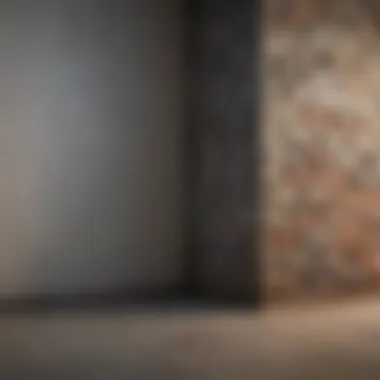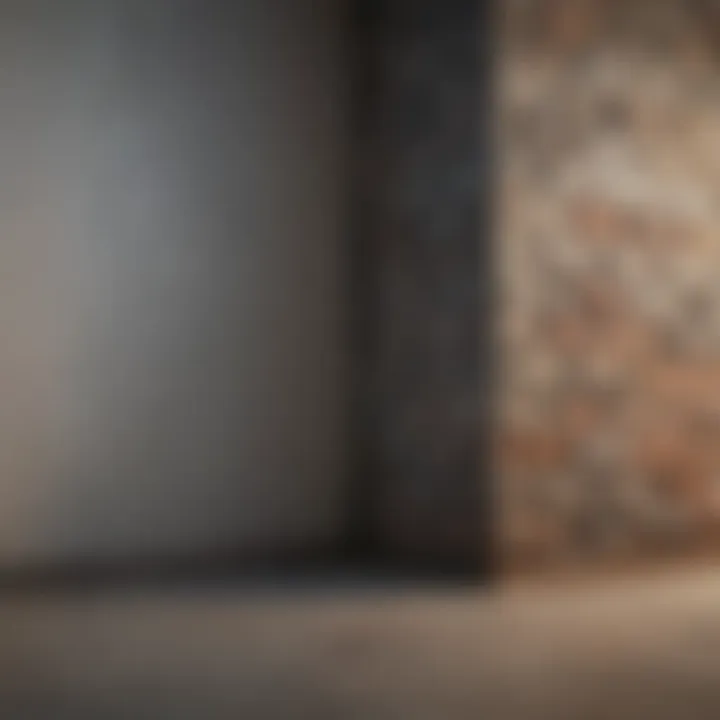Accurate Wall Square Footage Calculation Guide


Intro
Accurately determining wall square footage is essential for various projects, from painting and wallpapering to interior design and architectural planning. Understanding this measurement not only helps in budgeting but also ensures that the materials purchased are adequate for the task. This guide explores the systematic approach to calculating wall square footage, including the necessary tools, techniques, and considerations tailored for homeowners, design professionals, and those engaged in home renovations.
Feature Spotlight
The structure and design of walls significantly influence space aesthetics and functionality. Here, we explore how to factor in unique design elements when calculating wall square footage.
Exceptional Architectural Designs
When considering wall square footage, the unique characteristics of architectural designs play a crucial role. For instance, vaulted ceilings, arches, or angled walls create complexities. It's vital to adapt measurements to account for these features, as they can alter the amount of surface area needing coverage.
In such cases, break down calculations into smaller sections. Measure each distinct wall segment separately, summing their areas for an overall total. Always remember to include any windows or doors since these reduce the total wall area. Subtract their dimensions from the total calculated area to get a precise measurement.
Unique Decor Elements
Incorporating elements like built-ins, moldings, or decorative panels can affect wall square footage as well. These features typically require individual consideration, as they may not follow the standard dimensions of typical flat walls. When calculating footage, ensure to measure around any protrusions and indentations. This ensures you accurately account for the wall's surface that requires treatment, paint, or installation of wallpaper.
"Every design detail counts when calculating wall square footage, impacting both aesthetic and budget considerations."
Essential Calculating Techniques
While physical measuring tools are common, using a digital measuring app can increase accuracy. For straightforward rectangles or squares, simply multiply the height by the width. For example, a wall that is 10 feet high and 12 feet wide would yield 120 square feet.
For more complex shapes:
- Rectangular Walls: Height x Width
- L Shaped Walls: Measure each segment and add together
- Circular Walls: Use the formula for the area of a circle (πr²) for any rounded features
After measuring, always round up to ensure sufficient material. This is particularly vital in renovations, where unexpected gaps or irregularities often occur.
Finale
In sum, determining wall square footage is a precise task that demands attention to detail. By acknowledging architectural styles, unique decor elements, and applying accurate measuring techniques, homeowners and professionals can ensure projects proceed smoothly. The effectiveness of any renovation, interior design, or construction project hinges on accurate measurements, making this guide an essential tool for achieving success in any related endeavor.
Understanding Wall Measurements
Understanding wall measurements is crucial for anyone involved in design, renovation, or construction. Accurate measurements allow for effective planning and execution of projects, avoiding costly mistakes. When you grasp the principles behind wall measurements, several benefits arise.
- Precision in Estimation: Knowing how to measure walls properly enables more accurate estimations of materials needed, such as paint, drywall, or wallpaper. A precise square footage calculation affects budgeting effectively.
- Informed Design Decisions: For interior designers, having the exact dimensions of walls aids in spatial planning. Understanding measurements also assists in selecting appropriate furniture sizes and arrangements, ensuring the design flows well.
- Regulatory Compliance: Knowing the correct wall measurements aids in complying with building codes and regulations. When previous measurements are inaccurate, modifications may be needed to meet local standards.
- Project Management: For contractors and project managers, clear understanding of wall measurements leads to better time management and resource allocation. Accurately measuring walls allows for scheduling tasks more efficiently.
Basics of Square Footage
Square footage is a fundamental aspect of understanding spaces within a building. It is calculated by multiplying the height and width of a wall. Knowing how to derive this figure is important when planning renovations or new constructions. For instance:
- Width Measurement: Measure the distance from one end of the wall to the other at the base. It's essential to ensure the tape is straight and flat against the wall for accuracy.
- Height Measurement: Extend the measuring tape from the floor to the top edge of the wall. Always use a ladder if necessary to avoid injury or inaccurate readings.
Once you have both measurements, the calculation is straightforward:
Square Footage = Width x Height
This calculation provides you with a baseline that can be adjusted based on wall features or openings such as doors and windows.
Why Wall Square Footage Matters
Knowing the wall square footage can significantly impact various aspects of home improvement or construction projects. Here are key points to consider:
- Budgeting for Materials: Properly estimating the square footage helps in determining how much paint, drywall, or other materials are needed. This avoids overordering or underordering.
- Time Management: Underestimating the square footage can lead to project delays due to unexpected material needs. Accurate calculations allow for better scheduling and resource allocation.
- Resale Value: For homeowners, understanding the implications of accurate wall measurements can enhance property value. Potential buyers are more likely to be attracted to properties that have been well-maintained and properly measured for efficiency.
"Understanding and accurately determining wall square footage ensures your projects are successful, budget-friendly, and timely."
Essential Tools for Measurement
Accurate wall square footage calculations depend heavily on the tools used. Utilizing the right measurement tools not only enhances precision but also improves efficiency during the calculation process. A proper measurement tool can save time and minimize errors, which are crucial when planning renovations or any construction work. This section will explore three key types of tools that facilitate measuring wall spaces effectively.
Measuring Tape Overview
A measuring tape is a fundamental tool in any measurement task. It offers simplicity and accessibility. Typically, these tapes are flexible and can be easily rolled up when not in use. Most are marked in both imperial and metric units, accommodating different preferences. When using a measuring tape, it is important to ensure that the tape is fully extended to avoid any slack that might lead to inaccurate measurements. For best results:
- Begin at one end of the wall and extend to the other.
- Keep the tape straight for accurate readings.
- Note down the measurement promptly to avoid confusion later.
The downside of measuring tape is its reliance on manual handling, which can lead to human errors. However, it remains a valuable tool, especially for small projects or quick assessments.
Laser Measuring Devices
Laser measuring devices redefine accuracy. They utilize laser technology to measure distances quickly and with high precision. By pointing the device at the wall and pressing a button, individuals can receive almost instantaneous readings. These devices minimize the impact of personal error and make it possible to measure larger spaces with ease. Important points to consider:
- Ensure that the device is calibrated correctly before use.
- Avoid obstacles in the path of the laser to maintain measurement accuracy.
- Utilize the device’s additional features, such as recording multiple measurements, which can help in complex calculations.
The convenience of laser measuring devices makes them particularly advantageous for professionals in design and architecture, but they are equally beneficial for homeowners engaged in extensive renovations.
Digital Measuring Tools


Digital measuring tools combine the user-friendliness of analog tools with the precision of lasers. These electronic devices often include features like automatic calculations and memory storage for multiple measurements. They may integrate with smartphone applications for further functionality, allowing users to save and organize measurements in digital format. Some noteworthy advantages include:
- Displaying measurements in various units.
- Calculating square footage directly based on input dimensions.
- Providing a more comprehensive analysis of room dimensions by storing data.
Each of these tools plays a vital role in enhancing the measuring process. Choosing the right tool ultimately depends on the specific requirements of your project, whether it is a simple home renovation or a complete home construction. Understanding the strengths of each tool aids in making an informed decision.
Calculating Basic Square Footage
Calculating basic square footage is a fundamental step in the process of assessing wall area accurately. Understanding how to calculate square footage allows homeowners, designers, and builders to make informed decisions related to materials, budgeting, and overall project scope. Whether engaging in renovation or new construction, knowing the precise wall measurements can prevent costly errors later on.
Several specific elements contribute to the efficient calculation of square footage. First, knowing the dimensions of each wall provides a clear framework. Additionally, applying the correct formula ensures that results meet expectations without confusion. Finally, converting measurements when necessary can further enhance accuracy during calculations.
Finding Wall Dimensions
To embark on the process of calculating wall square footage, identifying wall dimensions is paramount. To find dimensions, use a tape measure or a laser measuring tool to assess the height and width of each wall.
Measure from the floor to the ceiling to determine the height accurately. Next, measure the width from one end of the wall to the other. It is critical to ensure that measurements are taken at the correct angles and positions without any obstruction. This accuracy in the measurements is particularly vital when walls in irregular shapes or non-standard configurations are present.
Also, keep in mind:
- Double-check measurements: A small error can significantly impact total square footage.
- Record findings accurately: Maintain a clear record in a dedicated notebook or an electronic device to avoid confusion later.
This methodical approach facilitates an organized calculation process to follow in subsequent steps.
Applying the Formula
Once wall dimensions are established, the next step is to apply the square footage formula. The formula for calculating square footage is straightforward:
[
\textArea = \textWidth \times \textHeight
]
By multiplying the width of the wall by its height, you arrive at the total area in square feet. For example, if a wall is 10 feet wide and 8 feet tall, the calculation would be:
[
10 \text ft \times 8 \text ft = 80 \text square feet
]
It is essential to apply the formula consistently for each wall to achieve the overall square footage for the designated space. Ensure to sum all individual wall areas if working with multiple walls.
In instances where the wall includes features like windows or doors, subtract those areas from the total to yield a more accurate figure for the wall.
Converting Measurements if Necessary
In some cases, measurements might require conversion. This could arise when working with different measurement systems, such as switching from inches to feet, or when dealing with metric units. Converting measurements accurately is crucial to maintaining precision during calculations.
For example, if wall dimensions are provided in inches, and one needs to convert to feet, the formula is:
[
\textFeet = \textInches \div 12
]
So, if a wall measures 60 inches in width, the conversion to feet would be:
[
60 \text in \div 12 = 5 \text ft
]
It is also advisable to be attentive to the conditions of the conversion, ensuring all dimensions follow the same measurement system before applying the formula. This conscientiousness enhances the integrity of the calculations.
In summary, calculating basic square footage involves a systematic approach, grounded in understanding wall dimensions, applying the formula accurately, and making necessary conversions when required. By mastering these steps, securing a precise estimation becomes achievable, forming a solid groundwork for further exploration in wall square footage assessment.
Factors Affecting Wall Square Footage Calculations
Understanding the various factors that influence wall square footage calculations is essential. These factors not only determine the overall area but also impact the accuracy of planning for construction or renovation projects. When someone is estimating wall square footage, they must consider elements that can skew the results if neglected. Mistakes in this awareness can lead to miscalculations which may affect budgeting and material requirements.
Wall Features and Fixtures
Features such as shelves, cabinets, and built-ins are prevalent in many interiors. These elements can complicate the measurement process and must be accounted for when determining the square footage of a wall. Typically, these items occupy physical wall space, reducing the actual area available for paint or other finishes. Failure to consider them introduces inaccuracies. To get an exact figure, it is vital to subtract the area taken up by these fixtures from the total wall measurements. For example, if a wall is 10 feet tall and 20 feet wide, it typically has an area of 200 square feet. If a cabinet takes up 4 square feet, subtracting this from the total yields 196 square feet of usable wall space.
Ceilings and Closets
Ceiling configurations and closet shapes also play a vital role in accurate wall measurements. Ceilings may slope or have higher sections, which can change the area that walls occupy. When measuring, it’s necessary to factor in the ceiling contours that might affect the overall height of the walls. Closets can further complicate calculations, especially when they involve doors or are designed with protrusions. If a closet protrudes 2 feet into the room on a wall that is 15 feet long, you must assess how that changes the overall space available on that wall. Clear understanding of these features allows for more precise measurements.
Windows and Doors
Windows and doors represent significant deductions in wall calculations. Both are essential for functionality and aesthetics, but they also occupy space that would otherwise be accounted for as wall area. For each window or door frame, the height and width should be measured to determine the square footage. For instance, a standard door might measure 3 feet wide and 7 feet tall, representing 21 square feet of wall space that needs to be subtracted from the total. Failing to account for these openings can significantly distort calculations. Reliable and accurate measurements are critical to ensure that particular designs achieve the desired outcomes.
Accurate calculations lead to successful projects and wise investment choices.
Each of these considerations play a significant role in attaining precise measurements. Keeping track of these factors guarantees better outcomes in planning and execution, thus saving both time and resources in the long run.
Specific Considerations for Different Wall Types
When calculating wall square footage, understanding the different types of walls becomes essential. Each wall type presents unique characteristics that can alter measurements significantly. This section examines the variations between interior and exterior walls, the features of shear walls, and the relevance of partitions and fallbacks.
Interior vs. Exterior Walls
The distinction between interior and exterior walls can impact the overall square footage calculation. Interior walls are often thinner and may have less structural significance. They are primarily for room separation and do not usually support the building's weight. Their measurement focuses on height and length. On the other hand, exterior walls are crucial for structural integrity and insulation. They tend to be thicker as they often hold the weight of the roof and upper floors, thus requiring more careful measurement.


When calculating square footage:
- Measure the height and the length of each wall carefully.
- Consider insulation and cladding that may increase the thickness of the wall.
- For exterior walls, include measurements for overhangs and any architectural features, like eaves and cornices.
This differentiation is important not only for accurate measurements but also for determining the materials needed for paint, paneling, or siding.
Shear Walls
Shear walls offer a significant role in structural stability by resisting lateral forces from wind and seismic activity. Due to their unique function, measuring shear walls requires more attention than standard walls. These walls are thicker and constructed of firmer materials to withstand these forces.
From a square footage perspective:
- Ensure to measure the entire height and width of the shear wall accurately.
- Include any special reinforcements or structural additions in your calculations.
- If a shear wall is part of a larger structural system, understanding its interaction with other walls may be necessary for comprehensive measurements.
In home renovations, recognizing shear walls is essential. Alterations to these walls can compromise the building's safety.
Partitions and Fallbacks
Partitions are often used to divide larger spaces into smaller rooms without adding structural support. Their dimensions are generally less than exterior or shear walls. Common materials include drywall or wood frames.
Fallbacks, on the other hand, refer to wall designs that retreat from the straight line of other walls, often adding aesthetic or functional value to spaces. Measuring these areas requires an understanding of both the primary measurements and the offset dimensions.
When calculating for partitions and fallbacks:
- Consider the wall's full height and its varying lengths, especially if they follow an irregular path.
- In open-plan designs, look at how partitions integrate with areas of movement to avoid errors in measurements.
This careful consideration of different wall types helps to produce accurate measurements, crucial for any subsequent steps in home renovation or construction.
Accurate square footage calculation determines material needs and impacts overall renovation budgets.
Practical Examples of Wall Square Footage Calculation
Understanding practical examples of wall square footage calculation is crucial for accurate assessments in both residential and commercial settings. When tackling painting, drywall installation, or any renovation work, knowing the square footage helps in budgeting, estimating material needs, and ensuring project efficiency. This section will provide scenarios and models that clarify how to apply theoretical knowledge to real-world situations.
Single Wall Measurement Scenario
To measure a single wall, start by determining its height and width. For instance, a typical living room wall may measure 10 feet high and 12 feet wide. Using the formula for square footage, multiply the height by the width:
Square Footage = Height x Width
Square Footage = 10 ft x 12 ft = 120 sq ft
This straightforward calculation is essential for homeowners who might want to repaint without purchasing excess paint. Always consider subtracting areas for windows and doors. If this wall has a 3-foot by 2-foot window, calculate that area:
- Window area = Height x Width
- Window area = 3 ft x 2 ft = 6 sq ft
Adjust the wall's square footage:
Adjusted Square Footage = sq ft - sq ft = sq ft
This modified figure reflects a more accurate material requirement for paint, wallpaper, or wall covering.
Multi-Wall Measurement Process
Measuring multiple walls in a room follows a similar procedure. Collect the dimensions for each wall. For example, in a room with four walls, you may measure:
- Wall 1: 10 ft x 12 ft
- Wall 2: 10 ft x 12 ft
- Wall 3: 10 ft x 10 ft
- Wall 4: 10 ft x 10 ft
Calculating individual wall areas provides an overall picture:
- Wall 1: 120 sq ft
- Wall 2: 120 sq ft
- Wall 3: 100 sq ft
- Wall 4: 100 sq ft
Next, sum these areas:
Total Square Footage = 120 + 120 + 100 + 100 = 440 sq ft
Adjust this total if necessary by subtracting the areas of doors and windows across all walls. This precise approach assists in budgeting for materials and understanding the scale of the project.
Considerations for Irregular Shapes
Irregular wall shapes may require additional attention. If a wall has a niche, alcove, or any non-standard feature, additional steps ensure accuracy. Break the area into simpler shapes, like rectangles or triangles. After calculating the area for these segments, sum them for a comprehensive measurement.
For example, consider a wall with a rectangular section of 8 ft x 6 ft and an alcove that is 4 ft x 3 ft:
- Rectangular area = 8 ft x 6 ft = 48 sq ft
- Alcove area = 4 ft x 3 ft = 12 sq ft
Total for this scenario:
Total Square Footage = sq ft + sq ft = sq ft
Employing this method for complex walls guarantees a more reliable figure than attempting to measure irregular sectors at once. This ensures every detail is accounted for, significantly enhancing project execution.
Common Mistakes in Wall Square Footage Estimation


Accurate calculation of wall square footage is essential for various projects, from renovations to new constructions. Yet, many people make errors that can significantly affect the outcome of their work. Understanding and avoiding these common mistakes can lead to more precise estimations and ultimately save time and cost.
Overlooking Protrusions
Protrusions such as shelving, moldings, or built-in fixtures are frequently neglected during measurements. Not accounting for these features can lead to an underestimation of the square footage. This oversight can manifest in multiple ways.
- Inaccurate Material Estimates: If the calculations do not factor in protrusions, you might order insufficient materials. For example, a wall with shelves needs coverage around those shelves.
- Impaired Aesthetics: Failing to consider protrusions can lead to uneven wall finishes or failures in achieving desired design standards.
When measuring, take time to note these features. Use a pencil to mark locations, ensuring a comprehensive approach. This preventive step can mitigate future complications and costs.
Ignoring Measurement Imbalances
Measurement imbalances occur when uneven surfaces or variations in wall height are not accounted for. Many assume walls are uniform in height and structure, which may be a flawed understanding.
- Floor Unevenness: Floors may not be level, leading to variations in wall heights not immediately visible. Use a laser level to identify discrepancies that might otherwise be overlooked.
- Structural Elements: Pipes, ducts, or electrical outlets can create uneven walls. Not including these elements in the initial assessment can drastically affect your square footage calculations.
By carefully evaluating every aspect of the wall during measurements, you can avoid costly errors that arise from the previous point of assumption.
"Your wall may appear straight and level, but factors hidden may be at play. It's crucial to measure correctly to ensure accuracy in your results."
Taking these considerations into account helps create a more accurate portrayal of the wall in terms of square footage. By focusing on these common mistakes, one can significantly enhance the quality of project outcomes, proving that careful measurements allow for greater reliability in both budget and design.
Implications of Accurate Square Footage Calculations
Understanding wall square footage is not merely an exercise in measurement. It has profound implications, particularly when it comes to budgeting and material usage in renovation projects. Accurate square footage calculations translate into informed decisions, enabling smooth project execution and ensuring economic efficiency. Every inch counts when planning renovations, as underestimating or overestimating can lead to increased costs, wasted materials, or extended timelines.
Budgeting for Renovations
When embarking on renovation projects, one of the first steps is establishing a budget. Accurate square footage calculations are critical for this process. By knowing the total wall area to be worked on, homeowners and contractors can better estimate costs for materials, labor, and other associated expenses.
Consider the following key aspects related to budgeting:
- Estimate Material Costs: Knowing the wall area allows for precise calculations of paint, wallpaper, or drywall needed.
- Calculate Labor Expenses: A clear understanding of the space aids in assessing how much labor will be required. Miscalculations can lead to either excess hiring or rushed work.
- Plan for Contingencies: An accurate estimate helps in setting aside a budget for unexpected issues that may arise.
A thorough budget contributes to a streamlined renovation process. Instead of facing budget overruns and delays, homeowners can make proactive decisions.
Material Requirements Analysis
Material efficiency is another significant implication of accurate square footage calculations. For procurement planning, knowing precise measurements is essential for analyzing and sourcing the correct amount of material.
Here are the benefits of accurate material requirements assessment:
- Reduce Waste: Over-ordering materials often leads to waste. Conversely, under-ordering can cause project delays and additional costs. Accurate measurements mitigate these risks.
- Informed Choices: With an understanding of the materials needed, one can explore the best products that fit within the budget without compromising quality.
- Itemized Lists: Creating a detailed inventory of required materials allows for better negotiations with suppliers and can lead to cost savings.
It's essential to remember that material decisions can impact not just the success of the renovation but also the environmental footprint of the project. By ensuring that the right amounts are sourced, we can minimize the ecological impact.
"Accurate square footage measurements create a pathway for smarter decisions, helping to align costs with expectations and project timelines."
Resources for Further Exploration
Exploring the topic of wall square footage calculation can be enhanced by utilizing a variety of resources. The importance of these resources lies in their ability to provide supplementary knowledge, tools, and methods that can aid in making accurate measurements. By taking advantage of these resources, you can deepen your understanding and streamline your projects, whether you are a homeowner or a professional.
Online Calculators and Tools
Online calculators and measuring tools are invaluable for those looking to determine wall square footage with efficiency. These platforms often allow users to input measurements directly, compute the square footage, and even provide helpful diagrams.
Utilizing these tools not only saves time but also minimizes the chance of human error in manual calculations. Common options include specific websites dedicated to construction and renovation projects that offer user-friendly interfaces.
For instance, sites like Calculator Soup enable users to calculate square footage by simply inputting the dimensions of their walls.
Additionally, many apps available for smartphones and tablets can help with measurements and calculations when you are on the go. This versatility makes them suitable for different environments, from home to job sites.
Books and Guides on Measurement Techniques
Books and guides dedicated to measurement techniques provide a foundation of knowledge for understanding wall square footage. These resources often cover not just the calculation itself, but also the context in which these measurements are used. You may find detailed discussions on best practices, common errors, and advanced techniques to improve accuracy.
Some notable titles include:
- "The Complete Book of Home Renovation" - This book offers insights into various home projects, including proper measurement techniques.
- "Architectural Drafting and Design" - This resource dives deeper into measurement standards in architecture.
These books can often be found in local libraries or purchased online. They serve as excellent references for both beginners and seasoned professionals, enhancing both theoretical knowledge and practical skills.
Ending
The importance of accurate wall square footage calculation cannot be overstated. Correct measurements lead to informed decisions regarding renovations, painting, and material selection. This section reflects on the main elements covered throughout the article, emphasizing the benefits that come from understanding wall measurements thoroughly. Accurate square footage helps homeowners and professionals alike manage budgets efficiently and ensures that materials purchased match specific project needs.
Summary of Key Points
Throughout this article, key points arise:
- Understanding Wall Measurements: It is critical to grasp how to measure walls correctly, including basic concepts of square footage and why it is significant.
- Essential Tools: Knowing what tools are available for measurement aids in choosing the right one for the task at hand, increasing accuracy.
- Factors Affecting Measurements: Many elements, from wall fixtures to irregular shapes, impact the final square footage, and acknowledging these factors helps in accuracy.
- Common Mistakes: Awareness of common errors, such as overlooking windows or miscalculating dimensions, can save time and resources.
- Resources for Further Learning: Utilizing online calculators or reading guides can deepen understanding and enhance measurement skills.
Final Thoughts on Accurate Measurement
Accurate measurement is the foundation for all construction and renovation projects. Inaccurate wall square footage can lead to overspending or shortages in materials, adversely affecting project timelines. Therefore, it is recommended to develop a methodical approach to conducting measurements. Engage with reliable tools, double-check calculations, and continuously educate oneself regarding different wall types. By doing so, you not only ensure the success of your current project but also build a valuable skill set for the future.
"Measurement is the key to success in any building project. It is the bridge between the concept and the reality of construction."
This concluding section reinforces the significance of meticulous measurement and how it feeds into broader project management and execution strategies. With the outlined knowledge and resources, readers are now well-equipped to tackle their wall square footage calculations with confidence.







